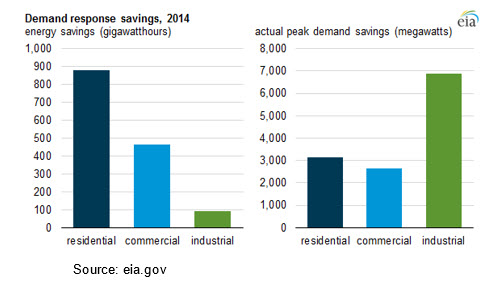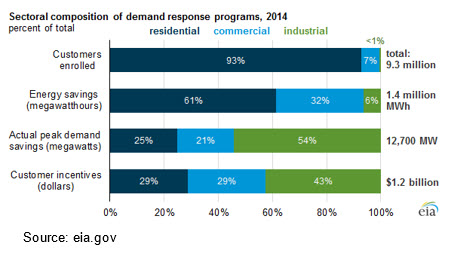WASHINGTON, Feb. 17, 2016 - Demand response in the electricity market involves the targeted reduction of electricity use during times of high demand and, in response, customers receive incentives for these reductions.
Demand response is one element of demand-side management, which includes increased adoption of energy efficient equipment at residential, commercial and industrial customer locations. Some programs allow electric power system operators to directly reduce customers’ load by temporarily turning off cooling equipment or industrial processes, for example.
In other programs, customers retain control and can choose to participate in announced demand-response events. Equipment such as advanced metering systems and appliances that can be remotely cycled by grid operators (for example, air conditioners and water heaters) is a component of demand-response programs.
 Based on data collected in EIA's annual survey of electric power sales,
revenue and energy efficiency, about 9.3 million customers in the United
States participated in demand response programs in 2014. Most of these
customers (93 percent) were in the residential sector, with the average
residential customer saving about 100 kilowatt-hours (kWh) annually and in turn
receiving about $40.
Based on data collected in EIA's annual survey of electric power sales,
revenue and energy efficiency, about 9.3 million customers in the United
States participated in demand response programs in 2014. Most of these
customers (93 percent) were in the residential sector, with the average
residential customer saving about 100 kilowatt-hours (kWh) annually and in turn
receiving about $40.
Commercial and industrial customers make up a small share of the number of demand-response customers (7 percent and less than 1 percent, respectively), but they provide larger shares of the energy savings and receive much larger incentives.
Industrial customers delivered more than half of all actual peak demand savings from demand response in 2014. The average annual commercial customer incentive was almost $600, while the average industrial incentive was more than $9,000.
California is the most active state in demand-response markets: The state contains 12 percent of the nation’s population but has 20 percent of the total demand-response customers and contributes 20 percent of the total peak demand savings.
 Because demand-response actions often occur during times of
peak electricity demand, demand response provides value to the electric system in
several ways. Lower demand means that less efficient, and often more expensive,
forms of electricity generation do not need to come online during times of high
demand. Reducing the amount of demand often results in lower wholesale
electricity prices. Less demand means less stress on transmission and
distribution systems, making them less likely to fail.
Because demand-response actions often occur during times of
peak electricity demand, demand response provides value to the electric system in
several ways. Lower demand means that less efficient, and often more expensive,
forms of electricity generation do not need to come online during times of high
demand. Reducing the amount of demand often results in lower wholesale
electricity prices. Less demand means less stress on transmission and
distribution systems, making them less likely to fail.
A recent Supreme Court ruling is expected to result in faster growth in demand response in the wholesale electricity markets that cover about 60 percent of U.S. power supply.
#30
For more news, go to: www.Agri-Pulse.com
